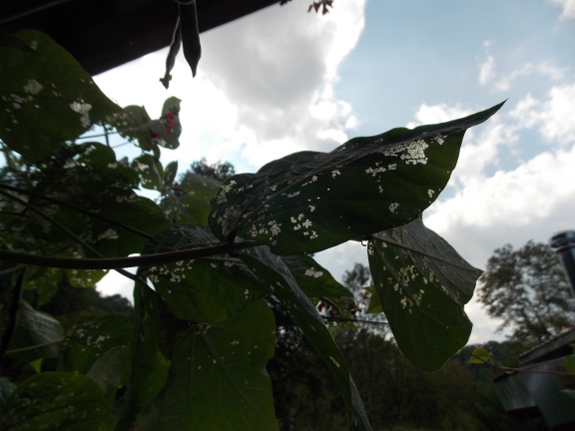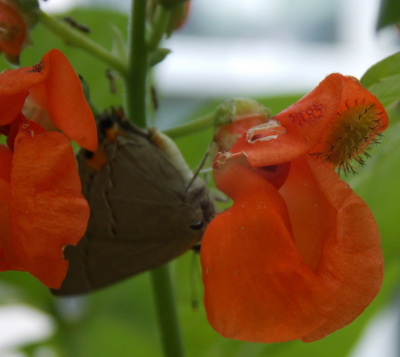
Two bean cover crops

I appreciated all of the thoughtful comments on my scarlet runner bean post
last weekend! Several of you correctly pointed out that the
species is actually a perennial, although the distinction won't make
much of a difference for most of us since (like tomatoes) scarlet runner
beans are perennials that act like annuals in temperate climates.
On the other hand, that reminder did point out that not only the green
beans, shelled beans, and flowers, but also the tubers of scarlet runner
beans are edible.
 However,
what I wanted to share today is a downside I just discovered of my
beautiful bean planting. Unfortunately, scarlet runner beans seem
to make awesome nurseries for Mexican bean beetles,
as you can tell from the holey leaves in the photo above (and from the
larva that was hiding in a photo in my previous post, repeated to the
left). We use the ultra-simple bean-beetle control method of
succession planting bush beans (explained in more depth in The Naturally Bug-Free Garden),
but adding scarlet runner beans to the mix means that this year's
beetle population exploded and quickly colonized my bush bean
plants. Good thing I'd already frozen several gallons of the
staple crop because the plants will probably soon bite the
dust.... I might try scarlet runner beans again, but this piece of
data suggests I should keep my for-food beans far away from my
for-beauty beans in the future.
However,
what I wanted to share today is a downside I just discovered of my
beautiful bean planting. Unfortunately, scarlet runner beans seem
to make awesome nurseries for Mexican bean beetles,
as you can tell from the holey leaves in the photo above (and from the
larva that was hiding in a photo in my previous post, repeated to the
left). We use the ultra-simple bean-beetle control method of
succession planting bush beans (explained in more depth in The Naturally Bug-Free Garden),
but adding scarlet runner beans to the mix means that this year's
beetle population exploded and quickly colonized my bush bean
plants. Good thing I'd already frozen several gallons of the
staple crop because the plants will probably soon bite the
dust.... I might try scarlet runner beans again, but this piece of
data suggests I should keep my for-food beans far away from my
for-beauty beans in the future.

On a semi-related note, our experimental fava beans
have come up! The seedlings look more like peas than like beans,
which is probably because fava beans are really a vetch. We hope
to experiment with eating both the fava bean seeds and the scarlet
runner bean seeds at lima bean stage...even though I don't think I've
ever eaten lima beans before in my life. For those of you who are
more experienced --- what kind of introductory recipe would you
recommend?
Want more in-depth information? Browse through our books.
Or explore more posts by date or by subject.
About us: Anna Hess and Mark Hamilton spent over a decade living self-sufficiently in the mountains of Virginia before moving north to start over from scratch in the foothills of Ohio. They've experimented with permaculture, no-till gardening, trailersteading, home-based microbusinesses and much more, writing about their adventures in both blogs and books.
Want to be notified when new comments are posted on this page? Click on the RSS button after you add a comment to subscribe to the comment feed, or simply check the box beside "email replies to me" while writing your comment.

I used to use this one years ago and it was pretty good. From "Laurel's Kitchen"
http://www.wedge.coop/food-resources/slow-cooker-breakfasts
Fava beans, which I grow every year, can be eaten raw. That's actually the primary way they're eaten in Europe. They're delicious with just bread and butter; people just bring them, unshelled, to the table. They're the most beautiful, tender green, big beans, and the inside of the pod is velvety. And, they're amongst the first spring harvest… so that makes them taste even better… like spring! On another note: some people start them in the garden in october/november for an early spring harvest. I choose to start them in february. They're beautiful plants, with tiny pretty flowers, and will keep growing new stalks late in the season (although with the humid climate here in North Carolina, they run into trouble by june).
Anna,
The most surprising part of your post was the acknowledgement that you have never eaten Lima beans?!? How could this be? A delicious food and part of your southern heritage. Next I am afraid that you will tell me that you do not eat field peas ( crowder, cowpeas).
Limas are a pain to pick and shell though.
Regards
Tim
Favas- I wrote a post on them on my blog a few years ago. Shell them, nick them with the heel of a knife, and put them in a bowl with some salt. After 20 minutes or so, rinse them and lightly steam. Heavenly.
Another excellent way is to grill them in their pods on a BBQ grill.